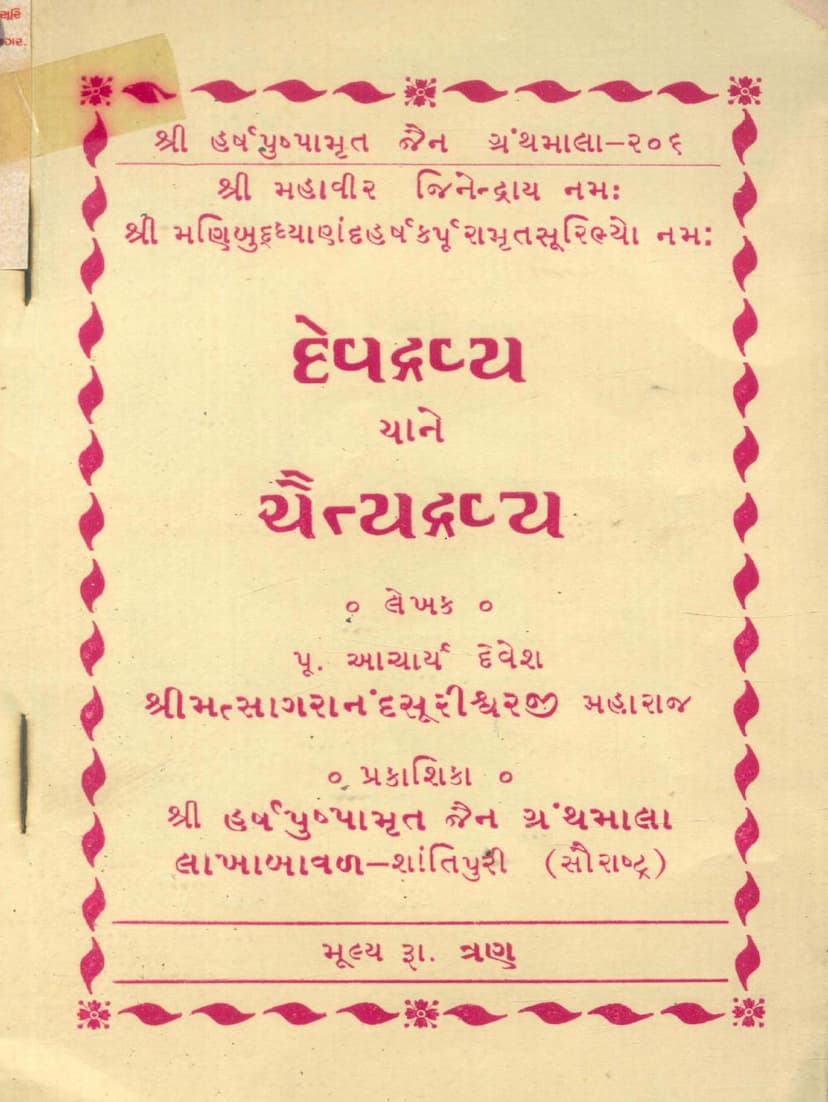Devdravya Ane Chaityadravya
Added to library: September 1, 2025

Summary
This Jain text, titled "Devdravya ane Chaityadravya" (Devotional Property and Temple Property), authored by Acharya Devesh Shrimat Sagaranand Surishwarji Maharaj, and published by Shri Harshpushpamrut Jain Granthmala, delves deeply into the significance and proper usage of Devdravya (properties dedicated to the divine) and Chaityadravya (properties related to temples and religious establishments).
The book emphasizes that the Jain religion is founded upon the teachings of the Aagamas and the guidance of great souls. It addresses common questions and clarifies misconceptions surrounding the management and purpose of these sacred properties.
Key Themes and Arguments:
- The Importance of Devdravya and Chaityadravya: The text asserts that the Jain scriptures provide detailed guidance on the management of temples, idols, scriptures, and the Chaturvidh Sangha (four-fold Jain community). It highlights that the rules for Devdravya, including its income, expenditure, and management, are well-defined and have always been upheld by enlightened individuals.
- Combating Misconceptions and Misuse: The book strongly refutes any attempts to distort or misinterpret the principles of Devdravya, often arising from speculation or a lack of understanding. It aims to provide clear answers to those who engage in such practices.
- The Ultimate Goal of Devdravya: A central argument is that the increase and protection of Devdravya are crucial duties. The author states that by increasing Chaityadravya, one can attain the highest spiritual attainment, that of a Tirthankar ( a spiritual teacher who establishes a religious order). This is presented not as hyperbole but as a direct consequence of the devotion and merit accumulated through such acts.
- Scriptural Basis for Devdravya: The text extensively quotes scriptural verses and the teachings of revered Jain scholars like Haribhadra Suri to support its claims. These quotes illustrate how dedicating wealth to the divine and temples leads to significant spiritual benefits, including attaining the status of a Tirthankar, Ganadhar (chief disciple of a Tirthankar), or Pratyekbuddha (an independently enlightened being).
- Examples from Jain History: The book draws upon historical examples, such as King Shrenik's devotion to Lord Mahavir and King Chandpradyotan's endowments, to demonstrate the long-standing practice of contributing to Devdravya.
- Prohibition of Misappropriation: A significant portion of the text is dedicated to warning against the misuse, misappropriation, or neglect of Devdravya. It quotes scriptures that condemn such actions, stating that any monk, nun, or lay follower engaging in such practices will face severe consequences, including being labeled as irreligious, misguided, and falling into hellish realms.
- Rules for Monastics (Sadhu/Sadhavi): The text emphasizes that even for monastics, Devdravya is strictly for the use of the temple or divine establishment. Any use of Devdravya for personal needs by a monastic is considered a grave sin, leading to penance and spiritual degradation. This is supported by quotes detailing the severe penances incurred for even the slightest misuse of temple property.
- The Role of the Sangha: The book clarifies that the Chaturvidh Sangha (monks, nuns, male and female lay followers) is meant to protect and increase Devdravya, not to misappropriate it. Any group that deviates from this principle cannot be considered a true Sangha.
- The Purpose of Rituals and Offerings: The text addresses the practice of offerings and rituals (like uchhamani or bidding), emphasizing that the wealth generated from these acts is strictly Devdravya and cannot be diverted for other purposes.
- Consequences of Neglect and Destruction: The book forcefully condemns the destruction or neglect of Devdravya, stating that even a monk who remains indifferent to its destruction incurs infinite cycles of rebirth. This is a serious offense against the Jain teachings and can lead to severe spiritual downfall.
- The True Meaning of "General" Fund: The text clarifies that any "general" fund related to temples is also considered Devdravya and cannot be used for personal gain.
- The Merit of Protection and Increase: The book concludes by reiterating the immense spiritual benefits of protecting and increasing Devdravya, equating it to contributing to the growth of Jainism and the propagation of knowledge and right faith. It emphasizes that such actions lead to liberation (moksha) in a limited number of rebirths.
In essence, "Devdravya ane Chaityadravya" serves as a detailed scriptural and ethical guide for the Jain community, urging adherence to the strict principles governing sacred properties and highlighting the profound spiritual rewards of their proper stewardship.